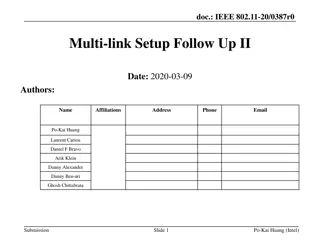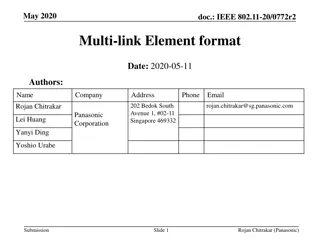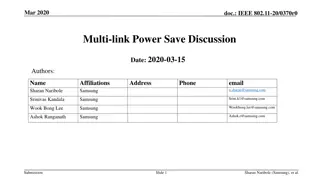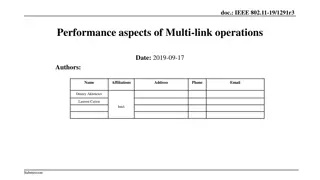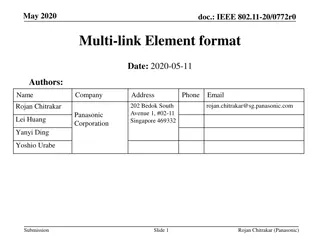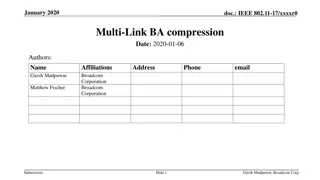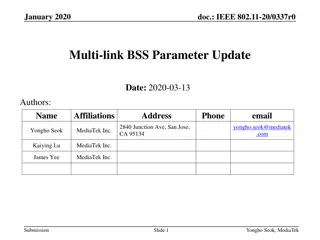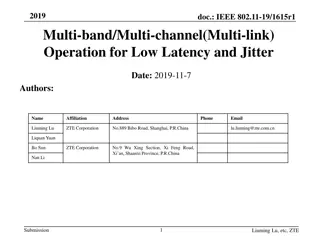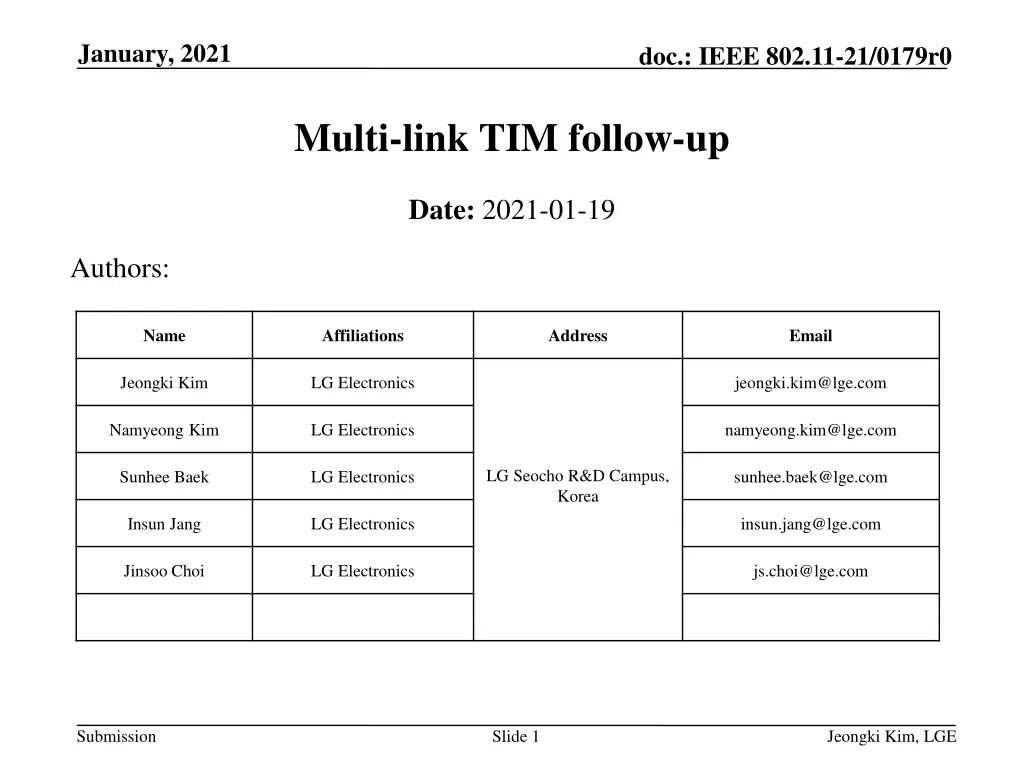
Enhancing MLD Level TIM Mechanism in IEEE 802.11-21/0179r0
This document discusses a method to enhance the MLD level TIM mechanism for default TID-to-link mapping, focusing on traffic indication improvements in IEEE 802.11 networks. It covers topics such as multi-link setup, AID assignment, buffered traffic indication, and waking up STAs in non-AP MLDs.
Uploaded on | 0 Views
Download Presentation

Please find below an Image/Link to download the presentation.
The content on the website is provided AS IS for your information and personal use only. It may not be sold, licensed, or shared on other websites without obtaining consent from the author. If you encounter any issues during the download, it is possible that the publisher has removed the file from their server.
You are allowed to download the files provided on this website for personal or commercial use, subject to the condition that they are used lawfully. All files are the property of their respective owners.
The content on the website is provided AS IS for your information and personal use only. It may not be sold, licensed, or shared on other websites without obtaining consent from the author.
E N D
Presentation Transcript
January, 2021 doc.: IEEE 802.11-21/0179r0 Multi-link TIM follow-up Date: 2021-01-19 Authors: Name Affiliations Address Email Jeongki Kim LG Electronics jeongki.kim@lge.com Namyeong Kim LG Electronics namyeong.kim@lge.com LG Seocho R&D Campus, Korea Sunhee Baek LG Electronics sunhee.baek@lge.com Insun Jang LG Electronics insun.jang@lge.com Jinsoo Choi LG Electronics js.choi@lge.com Submission Slide 1 Jeongki Kim, LGE
January, 2021 doc.: IEEE 802.11-21/0179r0 Abstract In this contribution, we propose the method for enhancing MLD level TIM mechanism for considering default TID-to-link mapping Submission Slide 2 Jeongki Kim, LGE
January, 2021 doc.: IEEE 802.11-21/0179r0 Introduction Traffic indication in TGbe D0.3 (35.3.9.4 ) An AP MLD shall assign a single AID to a non-AP MLD upon successful multi-link setup. All the STAs of the non-AP MLD shall have the same AID as the one assigned to the non-AP MLD during multi-link setup. An AP MLD shall indicate pending buffered traffic for non-AP MLDs using partial virtual bitmap of TIM element in a Beacon frame as described in 9.4.2.5 (TIM element). The MLD level TIM will be used for default TID mapping traffic TIM for the specific TID-to-link mapping is TBD In the REVmd, if a non-AP STA receives the TIM for the STA, the STA sends PS-Poll to indicate its awake state When a non-AP MLD receive MLD level TIM, the non-AP MLD decides how many STAs in the MLD should be waken up, which will be non-AP MLD s implementation-specific For example, the MLD can decide to wake up all STAs in the MLD to retrieve the DL data fast or one or some STAs in the MLD to save its power more Submission Slide 3 Jeongki Kim, LGE
January, 2021 doc.: IEEE 802.11-21/0179r0 Non-AP MLD operation for MLD level TIM Basically, non-AP MLD does not know how much data AP MLD has for the non-AP MLD and the non-AP MLD decides its wake-up operation without considering a mount of buffered data Note that a STA in a single link does not need to know the amount of the DL buffered data because the AP will deliver the DL buffered traffic to the STA on the single link when the STA wakes up When a single STA in the non-AP MLD wakes up, if the AP MLD has a lot of DL buffered data for the non-AP MLD, the DL data will be delivered to the non-AP MLD lately, especially when the selected link is congested When all STAs in the non-AP MLD wakes up, if the AP MLD has small amount of DL buffered data for the non-AP MLD, the DL data will be delivered to the non-AP MLD on only one link and other links are not used so that the power consumption of the non-AP MLD will be increased Submission Slide 4 Jeongki Kim, LGE
January, 2021 doc.: IEEE 802.11-21/0179r0 Proposal (1/4) AP MLD can provide the information about the buffered traffic with the non- AP MLD Amount of buffered DL data TID information related to the buffered DL data Others Based on the received information, the non-AP MLD can decide how many STAs in the MLD should be awaken Submission Slide 5 Jeongki Kim, LGE
January, 2021 doc.: IEEE 802.11-21/0179r0 Proposal (2/4) Case 1: Sending the DL buffered traffic related information with TIM in Beacon *TIM (MLD1) * Buffer status of MLD1 AP1 of AP MLD1 STA1 of non- AP MLD1 Beacon Data PS-Poll BA AP2 of AP MLD1 Data STA2 of non- AP MLD1 PS-Poll BA STA1 and STA2 are awaken based on the buffer status AP3 of AP MLD1 STA3 of non- AP MLD1 Submission Slide 6 Jeongki Kim, LGE
January, 2021 doc.: IEEE 802.11-21/0179r0 Proposal (3/4) Case 2: Including the DL buffered traffic related information in DL data *TIM (MLD1) AP1 of AP MLD1 STA1 of non- AP MLD1 Data + Beacon BSR of MLD 1 PS-Poll BA AP2 of AP MLD1 Data STA2 of non- AP MLD1 PS-Poll BA STA1 is awaken AP3 of AP MLD1 STA3 of non- AP MLD1 Submission Slide 7 Jeongki Kim, LGE
January, 2021 doc.: IEEE 802.11-21/0179r0 Proposal (4/4) Case 3: Hybrid indication to alleviate the Beacon overhead *TIM (MLD1, 2) * Buffer status of MLD2 AP1 of AP MLD1 STA1 of non- AP MLD1 Data + Data Beacon BSR of MLD 1 PS-Poll BA AP2 of AP MLD1 Data STA2 of non- AP MLD1 PS-Poll BA STA1 of MLD 1 is awaken STA1 of non- AP MLD2 PS-Poll BA STA2 of non- AP MLD2 Submission Slide 8 Jeongki Kim, LGE
January, 2021 doc.: IEEE 802.11-21/0179r0 Example of Signaling For case 1 (with TIM) Buffer status report of non-AP MLD can be carried in the element Scaling factor Element ID = BSR of non-AP MLD Length MLD ID information Queue size of MLD Repeated for each MLD For case 2 (within DL data) Buffer status report of non-AP MLD can be carried in A-Control field Control ID = BSR of non-AP MLD Scaling factor Queue size of MLD Submission Slide 9 Jeongki Kim, LGE
January, 2021 doc.: IEEE 802.11-21/0179r0 Conclusion When a non-AP MLD receives TIM indicating the MLD for default mapping traffic, the non-AP MLD need to decide how many links should be awaken To select the proper number of the links, AP MLD can provide the non- AP MLD with some information such as the buffer status of the non-AP MLD or traffic ID/traffic characteristic The information can be carried with the TIM information or DL data frame Submission Slide 10 Jeongki Kim, LGE
January, 2021 doc.: IEEE 802.11-21/0179r0 Straw Poll 1 Do you agree to add the following in R1? When an AP of an AP MLD sends a traffic indication to a non-AP STA of a non-AP MLD with the default TID mapping traffic, the AP can provide the non-AP STA with amount of buffer traffics for the non-AP MLD Submission Slide 11 Jeongki Kim, LGE
January, 2021 doc.: IEEE 802.11-21/0179r0 Straw Poll 2 Do you agree to add the following in R1? When an AP of an AP MLD sends a non-AP STA of a non-AP MLD the DL data frame, the AP can provide the non-AP STA with amount of buffer traffics for the non-AP MLD Submission Slide 12 Jeongki Kim, LGE

